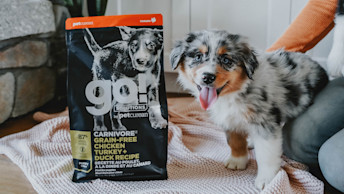June 2, 2025
Choosing the Best Dog Food Without Fillers or Preservatives

More and more pet parents are asking smart questions about what’s actually in their dog’s bowl. One of the big ones? What are fillers, and should I avoid them?
Let’s break it down in a simple, clear way—so you can feel confident in your choices.
What Are Fillers in Dog Food?
“Filler” is a loaded and often misunderstood term. While there’s no official or regulated definition in the pet food industry, it’s commonly used to describe ingredients seen as undesirable, due to labeling perceptions, nutritional value, or sourcing concerns.
We define fillers as ingredients that do not meaningfully support your pet’s health or the formulation goals of the recipe, often lacking essential nutrients, functional health benefits, or overall product quality.
Some common ingredients seen as fillers include:
- Corn
- Wheat
- Soy
Although these ingredients all contain essential nutrients, are digestible when sufficiently processed, and can support product quality and functionality, when used in excess they may compromise the overall nutritional balance. When these ingredients are misused, becoming cost-saving fillers, it can detract from a well-formulated pet food . If you're looking for the best dog food without fillers or artificial preservatives, these are exactly the things you want to look for.

Recommended Solution
Premium Dog Food with Thoughtful Ingredients
Every ingredient we use is carefully chosen to serve a clear purpose – nothing is added that does not meaningfully contribute to the recipe, and your pet’s wellbeing.
View dog food
Is Corn in Dog Food Bad?
Corn isn’t inherently harmful to dogs, and when appropriately processed, it’s a digestible source of carbohydrates and energy. It’s often used to add bulk to some foods, but it can also be added to provide calories to fuel daily activity.
While many dogs may tolerate corn just fine, others may experience digestive issues or sensitivities, though it is important to note that it is not a commonly reported allergen for dogs.
More importantly, corn doesn’t offer the same broad spectrum of amino acids, the concentrated nutrient density or phytonutrients like antioxidants found in ingredients like whole meats, fruits, and vegetables. For pet parents seeking diets with a higher concentration of animal-based protein and fewer plant derived carbohydrate sources, often perceived as fillers, corn might be an ingredient they choose to limit or avoid.
Is Wheat in Dog Food Bad?
Wheat, like corn, provides carbohydrates as a source of energy, and can be used in dog foods for various purposes. While not every dog is allergic to wheat, it’s one of the more common food sensitivities in dogs. Signs of wheat intolerance can include itchy skin, ear infections, and upset stomachs. Choosing a dog food without wheat can help reduce the risk of these issues, especially if your dog has a sensitive digestive system.
Is Rice in Dog Food Bad?
Not all grains are created equal. While white rice can sometimes be lumped in with other fillers, possibly due to its more refined nature, it offers significant benefits in pet foods along with its cousin, brown rice.
Brown rice is a whole grain that retains its bran and germ, providing beneficial fiber, B vitamins, and minerals that support healthy digestion and overall wellbeing. White rice is an easily digestible source of carbohydrates (AKA energy), protein, B vitamins and essential minerals, especially folate and manganese. While brown rice may be slightly higher in fiber, both are nutritious pet food additions when used smartly, in moderation.
What About Soy in Dog Food?
Soy is a plant-based protein source that some brands use as a cost-effective alternative to meat. Soy is a known allergen and may cause digestive issues in some dogs.
While soy protein is considered a complete protein, the bioavailability of these amino acids can differ compared to high-quality animal proteins.
If your goal is to feed a diet that prioritizes animal protein sources or if your dog shows signs of sensitivity, choosing a soy-free dog food may be a more appropriate choice.
What Are Preservatives Used for in Dog Food?
Preservatives are essential in pet food to prevent spoilage, inhibit the growth of harmful microorganisms, and extend shelf life, ensuring the food remains safe and nutritionally intact for pets over time.
Natural preservatives such as mixed tocopherols (forms of vitamin E) and rosemary extract are often used for their ability to extend shelf life and maintain nutritional quality. These natural antioxidants help prevent the oxidation of fats and degradation of fragile nutrients, ensuring that the food remains fresh, complete and balanced for its entire shelf life.

Artificial and synthetic preservatives, though, such as butylated hydroxytoluene (BHT) and butylated hydroxyanisole (BHA), have been linked to potential health concerns, including cancer and organ damage. While these synthetic preservatives are extremely effective in prolonging shelf life, the associated risks are notable, making natural preservatives a clear choice when prioritizing pet health.
Don’t wany any preservatives? No problem. Certain preparation methods can negate the need for these, such as retort, which rids the food of any pathogenic and spoilage microorganisms. When opened and exposed to oxygen, these foods function similarly to fresh foods and should be consumed within a few days, refrigerating any uneaten portion.
How to Choose the Best Dog Food Without Fillers or Artificial Preservatives
You’ve already done the hard part—asking the right questions. Now, you just need to find a food that matches your nutritional and ingredient philosophy.
Look for foods that are:
- Made with wholesome, purposeful ingredients and a nutritional philosophy that matches your needs
- Free from ingredients that don’t support your pet’s health
- Preservative-free or made with natural preservatives like mixed tocopherols (vitamin E)
- Transparent about what’s included—and why
When in doubt about an ingredient or formulation rationale, reach out to the company! The best dog food without fillers or artificial preservatives will always prioritize nutrient-dense ingredients over unnecessary extras, and brands should be happy to answer your questions.



